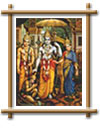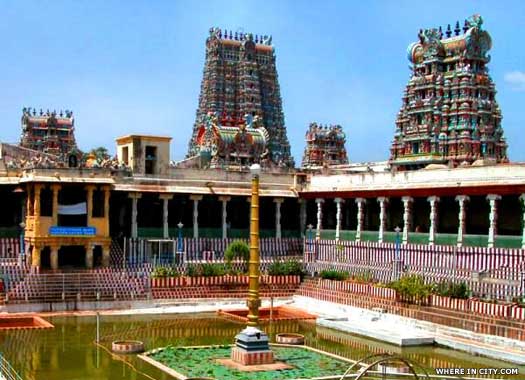Rajendra Chola-I (1012-1044 A.D) son of the Great Rajaraja-I, established this temple after his great victorious march to river Ganges on Northern India. He was originally called Madurantakan. He assumed the title of Rajendra during his coronation and continued to rule along with his father Rajaraja-I for a while. He achieved the supreme title of Cholas called Parakesari .
Rajendra-I, a great warrior and assisted his father, is numerous expeditions to elevate the Cholas to supreme power. The various expeditions, he conducted, were : Gangetic expedition, eastern/western Chalukyas, war against Cheras/Pandyas, Ceylon expedition, Kadaram (currently called as Burma) expedition etc.,
His empire extended the whole of southern India to river Thungabathra in the north India, for administrative and strategic purpose he built another capital and named Gangaikondacholapuram. The Gangaikondacholapuram temple, he constructed consists of 3 stories and surrounded by a huge fort like wall, the outer wall was greatly destructed during the English rule (1896 A.D) to reuse the building material (Granite rocks) for constructing the Lower Anicut (Dam across river Kollidam). He built around 10 temples at various places.
He assumed the title of Gangaikonda Cholan and named his new capital as Gangaikondacholapuram and he also constructed a huge Lake known as Chola Gangam that spreads 22 km mainly used for drinking and irrigation. A statue of Rajendra-I is found in Kolaram temple at Kolar of Karnataka state in India.
C. 1022 C.E. Rajendra undertook an expedition to the Ganges along the east coast of peninsular India. The emperor himself accompanying the army up to the banks of the Godavari river. The Chola armies conquered all the countries north of
Vengi, which included
Kalinga, Odda, Southern Kosala, the lower and upper Lada and finally the Vangaladesa (
Bengal). The triumphant Chola armies brought back waters from the river Ganges in golden vessels. Around the same time, the Cholas under the illustrious Rajendra Chola I also vanquished the Chalukyas of Manyakheta when the Chola protectorate of Vengi was threatened by Chalukyas Jayasimha II. Rajendra Chola I defeated Jayasimha-II Chalukya at Maski (Muyangi in Chola anals) between Eluru and Visayavadai (modern Vijayawada) and subsequently engaged the Chalukya in Kannada country itself i.e. in the Chalukyan capital of Mannaikadakkam (Manyakheta) "the war in which the Chalukya Jayasimha-II, full of fear, hid like a mouse and fleed the battlefield" (***). In scoring victories such as these, when the Chola armies seized the Chalukya flag, decapitated or slew various generals of the Chalukyas, with the Chalukyan king fleeing the battlefield, surrendering his wife to the victorious Chola monarch, with the Chola coffers filling up with riches from the Chalukya country, thus establishing their hold of the region between the Vaigai/Kaveri delta in Tamil country up to the Tungabhadra-Krishna basins in the Maharashtra-Andhra region (***) To commemorate this celebrated victory, Rajendra assumed the title of
Gangaikonda Cholan, "Irattapadi-konda Cholan", "Mannai-kondan" (the king who possessed Irattapadi (erstwhile land of the Rashtrakutas usurped by the Salukkis (Chalukyas) and the king who possessed (the Chalukyan capital) Manyakheta (Mannaikadakkam in Chola annals) and had the Siva Temple Gangakkondacholeswaram built(***). Soon after the capital was moved from Thanjavur to Gangaikondacholapuram. The city of Gangaikondacholapuram was probably founded by Rajendra before his 17th year.
Most of the Chola kings who succeeded Rajendra were crowned here. They retained it as their capital, reoriented and trained the efficient Chola army.
Chola Dravidian Culture
Chola rulers were active patrons of the during their regions
architectures,education, science, arts, ship construction, poetry, drama, music, ,business trading,dance and lost wax technique are flourished. The
beautiful Nataraja figure was first conceived during the Chola empire. They also constructed enormous stone temple complexes decorated inside and out with painted. While the
stone sculptures and the inner sanctum image empowering the temple remained immovable,
changing religious concepts during the 10th century demanded that the deities take part in a variety of public roles similar to those of a human monarch. As a result,
large bronze images were created to be carried outside the temple to participate in
daily rituals, processions, and temple festivals. The round lugs and holes found on the bases of many of these sculptures are for the poles that were used to carry the heavy images. Admired for the sensuous depiction of the figure and the detailed
treatment of their clothing and jewelry, Chola-period bronzes.























